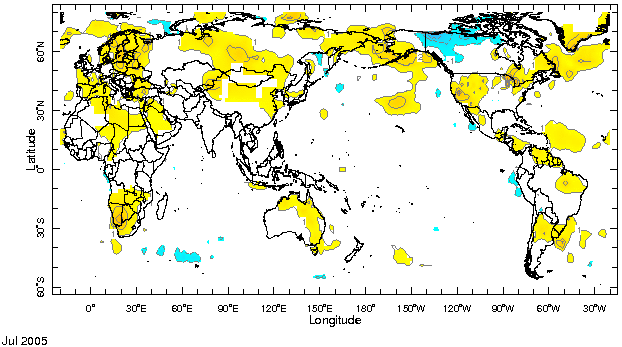|
IRI Climate Digest
August 2005
July Global Climate Summary
Climatological Background
In July, heating of the continents in the Northern Hemisphere results in strengthened monsoon systems which bring rains to West Africa, South Asia, and southwestern North America. In the Southern Hemisphere, winter has set in, with stronger north-south temperature gradients fueling active mid-latitude storm tracks.
Monthly Mean Temperature (1961-1990), data from the Climate Research
Unit, University of East Anglia


Monthly Mean Precipitation (1961-1990), data from the Climate Research
Unit, University of East Anglia


Temperatures
Highlights
The unusually warm conditions observed in southern Europe in June expanded north and eastward in July, covering much of eastern Europe. Temperatures were well above average across North Africa and much of southern Africa, outside the tropics. Unusually hot conditions developed across the southwestern United States during the month, while in north-central Canada, temperatures remained below the long term average.
Temperature Difference from the 1961-1990 mean, with data
from NCEP Climate Prediction Center, CAMS.


Precipitation
Highlights
Extremely heavy monsoon rainfall was observed in parts of western India, with more than 900 mm reported in Mumbai in a single 24-hour period. Rainfall was mixed across West Africa in July, with drier-than-average conditions across southern states along the Gulf of Guinea, and generally better rainfall to the north. To the north, heavy rainfall and flooding occurred across parts of southeastern Europe. Unusually dry conditions persisted across the central United States as well as northern South America.
Precipitation Difference from 1979-2000 mean, with data
from NCEP Climate Prediction Center, CAMS-OPI.


Oceanic Conditions
Sea surface temperatures in the eastern equatorial Pacific continue to indicate ENSO-neutral conditions. In the tropical North Atlantic, surface ocean temperatures continued to be well above average across much of the basin, and a weakening of the cooler-than-average conditions in the Gulf of Guinea was observed in July. In the tropical Indian Ocean, warmer-than-average conditions continued in the eastern part of the basin, while below-average temperatures emerged off of the coast of the Greater Horn of Africa. Outside the tropics, sea surface temperatures remained above average in the north-eastern North Pacific and northern North Atlantic basins.
Monthly Sea Surface Temperature Difference from the 1971-2000 mean,
with data from the Environmental Modeling Center, NCEP/NOAA.


Contents |
Special |
Impacts |
Climate |
Forecast
|

